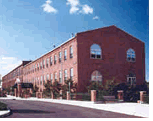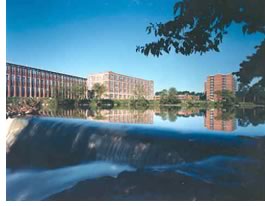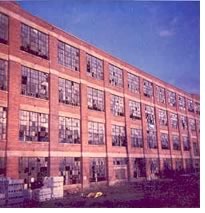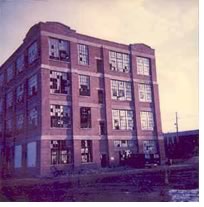
Adaptive re-use turns a derelict factory into a residential community

Associate Editor
Along the Northeastern and Mid-Atlantic corridor, many of the industrial complexes that were once bastions of American innovation and commerce have become tarnished shells, relics of our country's industrial era. Now, seeking to find new lives for these structures, developers are re-adapting the buildings for use in commercial, residential, and mixed-use projects.
 An
example of this type of adaptive re-use is The Mill at Little Falls, which
sits on the Passaic River in Little Falls, N.J., on a major dam and picturesque
waterfalls. The site was once the industrial complex for the Beattie Carpet
Mill, which used the falls as its power source. The Beattie family owned
the mill for more than a century, with the textile makers fabricating
uniforms for Union soldiers during the Civil War. When the company fell
on hard times, it shut its doors and its multiple buildings languished
and deteriorated.
An
example of this type of adaptive re-use is The Mill at Little Falls, which
sits on the Passaic River in Little Falls, N.J., on a major dam and picturesque
waterfalls. The site was once the industrial complex for the Beattie Carpet
Mill, which used the falls as its power source. The Beattie family owned
the mill for more than a century, with the textile makers fabricating
uniforms for Union soldiers during the Civil War. When the company fell
on hard times, it shut its doors and its multiple buildings languished
and deteriorated.
New development,
new life
During the mid-1980s, architect Barry Poskanzer, AIA, principal and partner
of Poskanzer Skott Architects, worked with a developer that had purchased
the property to devise a design scheme that would retain the architectural
integrity of the old mills, while adapting it for development of a new
residential community. Poskanzer said the site had been renovated several
times between 1850 and 1950, requiring the architects to work with a variety
of building styles and architectural details. For example, he said, the
building media included wood, stone, brick, concrete, and any combination
of those materials and more. To accommodate the vernacular of each mill,
the architect used a color palette, building materials, and scale complementary
to the original structures.
 "The
Mill at Little Falls shows the potential of adaptive re-use at its best,"
Poskanzer said. The mills are on a 13.4-acre suburban tract between two
heavily traveled streets, the dam, and the falls. Poskanzer and his firm
implemented a plan that included 220,000 square feet of renovations and
145,000 square feet of new construction, resulting in 330 units of housing,
a new parking garage, a recreation building, a riverside park, and other
open space. They knocked down buildings that were unusable, which created
the open space, and "fixed up the rotten parts," renovating
the remainder of the mills.
"The
Mill at Little Falls shows the potential of adaptive re-use at its best,"
Poskanzer said. The mills are on a 13.4-acre suburban tract between two
heavily traveled streets, the dam, and the falls. Poskanzer and his firm
implemented a plan that included 220,000 square feet of renovations and
145,000 square feet of new construction, resulting in 330 units of housing,
a new parking garage, a recreation building, a riverside park, and other
open space. They knocked down buildings that were unusable, which created
the open space, and "fixed up the rotten parts," renovating
the remainder of the mills.
 "Every
corner of every building was a unique new problem," Poskanzer said
of the diversity of the mills in the first phase of the project. As a
result, there are few floor plans that are the same as the one next door.
By contrast, the final component of the project, a $3.5 million gut renovation
of an industrial building into a nine-story, multifamily residential housing
complex, has about eight apartment plans for the entire building.
"Every
corner of every building was a unique new problem," Poskanzer said
of the diversity of the mills in the first phase of the project. As a
result, there are few floor plans that are the same as the one next door.
By contrast, the final component of the project, a $3.5 million gut renovation
of an industrial building into a nine-story, multifamily residential housing
complex, has about eight apartment plans for the entire building.
Community support
The Kramer Group, Clifton, N.J., now owns the site. But, as a result of
the 1987–1988 recession and other economic difficulties on the part
of the developers, it changed hands several times. It is only in the last
few years that the final building—which Poskanzer has redesigned
from the original site plan—is being built. The original cost of
the project was $30 million.
 "The
community itself was thrilled that the derelict mill was going to be fixed,"
Poskanzer said, adding that the town had also passed new and accommodating
zoning rules that encouraged this type of development. Unlike other developments
on which he has worked, Poskanzer said the fact that this property was
not bound by official preservation regulations gave him greater freedom
to develop the property in a way that was architecturally sound, but that
made economic sense.
"The
community itself was thrilled that the derelict mill was going to be fixed,"
Poskanzer said, adding that the town had also passed new and accommodating
zoning rules that encouraged this type of development. Unlike other developments
on which he has worked, Poskanzer said the fact that this property was
not bound by official preservation regulations gave him greater freedom
to develop the property in a way that was architecturally sound, but that
made economic sense.
"This is a textbook example of how underused sites and abandoned buildings can be restored as valuable real estate and tax assets, provide solutions for the scarcity of multi-unit housing, and add new vitality to a depressed community," Poskanzer said.
Copyright 2002 The American Institute of Architects. All rights reserved.
![]()
|
Photos by Alan Schindler Picture taken in 1984: the Beattie Textile Mill dates back to the mid-19th century. The Beattie family abandoned it, and it fell into disrepair. Poskanzer Skott Architects, Ridgewood, N.J., renovated the abandoned mill, creating 330 apartments, a parking garage, a recreational facility, and open spaces. The falls and the Passaic River, which once generated the textile factory's power, now serve as a picturesque backdrop for the residential community. |
|